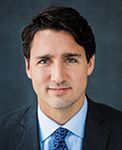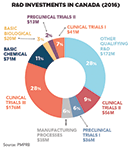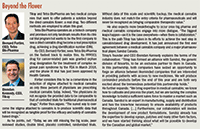Country Report: Canada
Away from the glare of publicity, a tranche of bold reforms in Canada, aimed at harmonizing the national health system and delivering value for money, are fast nearing completion.
This sponsored supplement was produced by Focus Reports
Report Director: Lisa Diericks
Report Coordinators: Anna-Luisa Vogt, Karen Xi
Report Assistant: Joseph Hall
Report Publisher: Diana Viola
Senior Editor: Louis Haynes
Editor: Patrick Burton
Graphic Assistance: Miriam León
Cover © Jean-Paul Riopelle, UNTITLED, 1956. Sotheby's
For exclusive interviews and more info, please log onto www.pharmaboardroom.com or write to contact@focusreports.net
CANADA COMING OF AGE
The tenth largest economy on the planet by GDP ranking, Canada clearly deserves its status at the international high table of the G7. However, despite the country repeatedly bringing forward world-class innovations and great minds, the nagging perception lingers that Canada's brand image remains understated. Perhaps nowhere is this more evident than in its thriving life sciences sector, all too often overshadowed by the bigger, more overbearing neighbor next door.

With universal healthcare solidly anchored in its system, Canada is already firmly cemented as a top ten pharmaceutical market. Moreover the local dynamics and growth trajectory are overwhelmingly positive: "Over the 2015-2016 period, we have witnessed the overall value of the Canadian pharmaceutical market rise by 3.5 percent to USD 22.6 billion," assures Rami El-Cheikh, national pharma and life sciences leader at PwC. Yet, despite these rosy figures, a complex, sprawling and splintered regulatory landscape has all too often proved overwhelming for new entrants. Equally challenging has been to stand out as an attractive investment destination with the world's largest pharmaceutical market, the United States, looming on the doorstep.
Finally, though, matters look set to change. Away from the glare of publicity, a tranche of bold reforms, aimed at harmonizing the national health system and delivering value for money, are fast nearing completion. Meanwhile, against this radical backdrop of price cuts, unified procurement and anchored budgets for priority areas like palliative care, Canada's life sciences pioneers have been busy trailblazing in entirely new market niches such as cannabinoids. Canadian life sciences may well be coming of age.
REPACKING THE BASKET
Discussion around pharma pricing models and their impact on the financial sustainability of the public healthcare apparatus tends to animate debate in most mature life sciences markets around the world and Canada is certainly no exception in this respect. Locally, discussion has intensified, as a serious reform package is in the works, much of which is already in the process of being enacted. Douglas Clark, executive director at the Patented Medicines Prices Review Board (PMPRB) acknowledges that Canada's "regulatory framework has traditionally failed to keep pace with important shifts in the operating environment," underlining that the board is now belatedly "in the midst of reworking and modernizing both its regulations and guidelines."

Brian Lewis, president and CEO of MEDEC, Canada's medtech association, adds "It is a well-known fact that the Canadian healthcare system is stressed, due to the expense of our public system as well as an aging population that is consistently growing. While the focus has predominantly been on cost control, we need to shift this focus and ask ourselves how we extract value that adds to system sustainability and limits the total cost."

Justin Trudeau, prime minister
The PMPRB was originally created by the state, back in 1987, primarily with a view to helping keep innovative drug prices in check by leveraging a reference basket of seven countries: namely France, Germany, Italy, Sweden, Switzerland, the United Kingdom and the US. As one of the core pillars of Bill C-22, the body was mandated to harness that mechanism to calculate patented drug price tags and to insulate consumers from skyrocketing medicine expenses.

Ginette Petitpas Taylor, federal minister of health
One critical element that is now set to change is the makeup of this basket of countries that Canada deploys as the reference for pricing referral. Precisely because the current selection of reference nations comprises some profligate, high roller mature economies where the average price of medicines can be considered somewhat exorbitant, former federal minister of health, The Honorable Jane Philpott, had in 2017, expressed her firm intent to remove high spending Switzerland and the United States from the basket. Consequently, the average price of reference would plummet: a longstanding objective of payers who have long been complaining that they are being squeezed by a relentless burden of escalating drug costs.

Imran Ali, senior manager, pCPA
Philpott persuasively argues that the original rationale behind incorporating free-spenders such as the US and Switzerland within the basket was that it would "likely generate a positive ripple effect whereby companies from those nations would find it worthwhile to invest heavily in R&D within Canada." However, not only do "the fruits of this aspirational choice appear not to have materialized," but the Canadian tax payer and individual patients have been left to pick up the tab for "the third highest drug prices and second highest per capita pharmaceutical spending in the OECD."

Douglas Clark, executive director, PMPRB
With the Canadian state struggling to contain drug spending that has increased by an eye-watering 184 percent as a share of GDP since 2000, it is perhaps unsurprising that the freshly installed, new federal minister of health, The Honorable Ginette Petitpas Taylor, remains staunchly committed to enacting her predecessor's intended reforms.

Brian O'Rourke, president and CEO, CADTH
READY FOR HARMONIZATION
Meanwhile, the current negotiation process for drug prices is also undergoing considerable overhaul. While full control over the pricing negotiations previously used to reside with the individual 13 provinces and territories, in 2010, a landmark decision to harmonize the process was taken. A full eight years later, the initiative is finally up and running.

Brian Lewis, president and CEO, MEDEC
Nowadays a freshly created public body, the pan-Canadian Pharmaceutical Alliance (pCPA), wields the power to negotiate prices on a federal level on behalf of public drug plans from all 13 provinces and territories. Its senior manager, Imran Ali, describes the process. "Once a drug receives the final recommendation from the Canadian Agency for Drugs and Technology in Health (CADTH), that is the agency for all provinces except autonomous Quebec, and/or Quebec's own HTA agency, called the Institut National d'Excellence en Santé et en Services Sociaux (INESSS), then that recommendation is passed on to the pCPA so that the various jurisdictions can discuss evidence and comparators in greater detail," he explains.

Chirfi Guindo, former president and managing director, Merck
What appears to be relatively straightforward in theory, however, actually poses significant challenges in practice, as many provinces are proving reluctant to yield power while the pCPA, itself, appears somewhat overloaded and under-resourced for the enormity of the task at hand. "I'm afraid to say that, up until last year, the pCPA's activities were conducted in the absence of federal leadership; on a shoestring budget; with a tiny office staff endeavoring to manage its hugely important work, so we've obviously been taking concrete remedial steps to improve upon this situation, but there's still much to do," attests Philpott.

Ali describes the pCPA's mission thusly: "to enhance access to clinically- and cost-effective drugs; to increase the consistency of decision making; to promote fair and stable drug prices over a sustained period; as well as to reduce duplication and improve resource allocation when it comes to price negotiations." Initial signs are certainly encouraging. According to Philpott, the pCPA is "already saving taxpayers over CAD 700 million (USD 741.9 million) through its collective buying power to negotiate better prices, despite only officially entering negotiations last year."

Allison Rosenthal, general manager, Otsuka
Despite the fact that the pCPA's mission is clearly defined, actually adapting to the new rules of the game has been challenging for some stakeholders. The PMPRB, CADTH, INESSS, and the industry players have all had to accommodate their role to the pCPA's new sphere of activity. "I think it's fair to say that necessarily there's been a bit of an adjustment period. While we would ideally be able to accomplish everything at once, resource constraints dictate otherwise and we always have found ourselves having to prioritize. You will encounter these sorts of trade offs and lag times occurring right across the pharma landscape, especially when fresh rules are in the process of coming into effect," admits Brian O'Rourke, president and CEO of CADTH.

Gaby Murphy, managing director, EMD Serono
"We are aware of the vital role played by the pCPA in leveraging the collective purchasing power of public payers to negotiate deep discounts for their respective drug plans," explains Clark. "We seek to complement that role by providing regulatory relief in instances where the monopsony power of the pCPA is an insufficient countervailing force to the monopoly power of the patentee."

Lee Ferreira, general manager, Ferring
OVERCOMING THE JITTERS
While not all drug developers necessarily share the payers' perspective about what constitutes optimum pricing reform, there is industry-wide appreciation about the fact that the current system is financially unsustainable and unnecessarily complex, and thus mass recognition of the need to harmonize pricing and reimbursement discussions on a federal level and to simplify the overall processes.

Jim Keon, president, CGPA
According to Merck's former president and managing director, Chirfi Guindo, the "sheer time taken to adopt new products is way too sluggish" and is a "direct consequence of an overbearing bureaucracy comprised of a tangled web of different agencies involved in product approval, HTA, pricing and reimbursement," he bemoans. "Unfortunately an additional repercussion of this messy state of affairs is that it is virtually impossible to reach a single overarching agreement for product listing so we need to take active steps to rectify these points."

Tarik Henein, president, Generic Medical Partners
Yet while there is general consensus that the time is ripe for overhauling the process, many CEOs are quick to warn against vigorous price slashing. Allison Rosenthal, general manager of Otsuka, says she "personally believes in the pCPA, but some price requests for innovative branded products are neither realistic nor sustainable in the long run."

Michel Charbonneau, executive vice president, Accord Healthcare
Many say that a race to the bottom on price would also harm patients. "Our biggest challenge is always to bring our products to the market, and if we are now going to be facing additional pressures around reimbursement listings and pricing, then that's going to be bad news for the patients," warns Lee Ferreira, general manager at Ferring Pharmaceuticals.

Madhusudhan Venkatachari, CEO, Natco Pharma Canada
Moreover, high price pressure can quickly degenerate into negative decisions on investment in innovation and discourage research activities being brought to Canada. "The last thing we want to see is a reduced range of medicines in the pharmacies because some companies have felt compelled to vacate their products from the marketplace or not launch them in the first place...such a scenario prevents both physicians and patients from making an informed choice, especially when there is only one product available on the market. Not all patients react the same to a treatment for a specific condition, which is why diversity in offering is so incredibly important," argues Ferreira.

Marina Vasiliou, managing director, Biogen
"Price should certainly not be the sole decision making criterion. When it comes to determining whether a product should remain on the market or not, the value to the patient and to the healthcare system needs to always be the primary consideration," she advocates.
Some also fret about the unpredictability that radical reforms might engender. Gaby Murphy, managing director of EMD Serono (Merck KGaA), describes the up-coming changes as disruptive in the sense that they loom over the heads of those endeavoring to formulate their business plans. "The big issue we are currently facing as an industry is to predict the impact these changes will have ... Historically, Canada has always been a Tier One market for product launches, but right now between 60 and 65 percent of all innovative drugs launched are being evaluated by the PMPRB and this is creating a degree of uncertainty."

Many even take issue with the general premise of significant price reductions. "There is a strong misperception that Canadians are paying too much for their drugs and this has been driven by recent price controversies, especially those in the US, but the reality of the price-listing agreement (PLA) model used within the public healthcare system in Canada is that the list prices are not the actual prices paid, which are a lot lower," highlights Merck's Guindo. "So we should really be looking at these plans with an objective eye and determining whether they are actually fair," he suggests.

Ross Glover, general manager, Taiho
EMD Serono's Murphy, likewise doubts "whether payers properly appreciate the importance of the life sciences industry in terms of employment and economic contribution to Canada" and calls for "reasonable pricing that takes into account this value generation." After all, the Ministry's own statistics demonstrate that the local life sciences segment accounts for more than 90,000 jobs in about 850 pharmaceutical and medical device firms, and represents CAD 7.8 billion (USD 6.1 billion) in GDP and CAD 13.2 billion (USD 10.3 billion) in merchandise exports.

Greig Estabrooks, general manager, Valneva
"This is comparable in scale to other R&D-intensive sectors, such as the aerospace and automotive industry. Overall, Canada's life sciences manufacturing sector stands as Canada's third-largest R&D spender, fifth-largest manufacturing exporter, and sixth-largest employer of R&D professionals," confirms The Honorable Ginette Petitpas Taylor.

Robin Hunter, general manager, Mallinckrodt
On balance, however, the general mood is collaborative and constructive. So far, there seems to have been little let up in foreign investment flows. The PMPRB calculated the total R&D expenditures of patentees in Canada as reaching CAD 918.2 million (USD 710.8 million) in 2016, and those figures remain pretty much constant today. Likewise, the ten largest global pharmaceutical players present on the local market all maintain an active in-country clinical trials footprint and some have even been betting big on heavyweight infrastructure projects such as Johnson & Johnson's opening of the first international JLAB in Toronto.

Brian Canestraro, general manager, Intercept Pharma
Moreover, despite the aforementioned concerns raised, the industry appears ready and willing to join forces proactively with the authorities in bringing about harmonious reform, "As members of the industry, we need to provide the required data when engaging in negotiations. Vice versa, payers have a responsibility to listen and consider thoroughly all data collected that demonstrates the cost savings of a more expensive treatment versus the expenses born out of a more affordable treatment that has to be prolonged in order to be efficient," asserts Ferreira.

Mark Smithyes, president, Labtician Théa
TOWARDS AN OUTCOME-BASED MODEL?
The circle may well be squared by reverting to an outcome-based pricing model. Ferring's Ferreira sees such a model as a possible "solution, providing it includes a listing on time and a monitoring of compliance, efficacy and safety criteria. Under such a model both parties, the industry and the payer, take a risk. As industry, we promise a specific outcome to which we will be held accountable." Guindo ingeminates this, reassuring that Merck-and the industry as a whole-is "prepared to work with the federal and provincial governments on a longer-term solution, which would provide certainty for their budgets as well as our business operations and ensure that Canadians gain more rapid access to the innovative medicines and vaccines that they deserve."

However, not all regulatory bodies seem on board for such an evolution. Brian O'Rourke of CADTH is skeptical about the validity of such a system: "very few countries have true outcomes-based performance agreements in the pure sense of the term. Most are financial-based agreements, and we have those in Canada as well," he says, further stressing the multiple challenges and questions such a model would create: "how do you develop it, who monitors and reports on the outcomes, and who determines whether outcomes have been reached?" Nonetheless, he identifies reassessments as being an axis CADTH will likely be pursuing in the future. Under such a logic, a listed drug's value could be reexamined after a certain period, in order to determine if its price and reimbursement are still illustrative of the outcomes it provides for patients.

Moreover, O'Rourke promises that, in 2018, CADTH will review its logic of operating on a "first in, first out" basis when assessing submitted drugs. The simple, but inflexible logic can be ameliorated in order to "get promising new therapies to patients faster," by assessing them first and "perhaps working towards delivering regulatory approval, our reimbursement recommendation, and maybe even the price negotiation in a similar window of time." This would potentially revolutionize the approval and reimbursement process in Canada, as another major complaint of industry players has been the multitude of layers and lack of predictability a submission has to go through before return on investment is eventually secured.

David Main, CEO and president, Aquinox Pharmaceuticals
TOUGH TIMES FOR GENERICS PLAYERS
For generics players the future looks potentially less promising. Many are struggling under on-going reforms to pricing and fretting over future evolutions in their market space, where price cuts are also a recurrent challenge. Today, generic penetration stands at 70 percent in Canada, while the US for instance boasts 89 percent penetration. Yet, in terms of sales, generic drug revenues account for only 22.4 percent of the value of the overall pharmaceutical market in Canada in 2016.

Despite this, there have been continued efforts on the part of provincial governments to increase pressure on generic prices. Jim Keon, president of the Canadian Generic Pharmaceutical Association (CGPA) candidly admits that, "In the past, our products at retail level were higher than the international average," but says that current initiatives to correct that discrepancy risk going too far. "The general public and the private payers do not understand the generic pharmaceutical business. Sometimes it seems as if they believe generic products grow on trees. We have tried to educate them on this matter by explaining that a lot of money goes into developing the active ingredient, doing the testing, developing the clinical trials and submitting it for regulatory approval," he exclaims.

Dwight Gorham, CEO, Pillar5 Pharma
"In terms of the generics space, I think that we are in a transition period which has affected the entire supply chain," he continues "There's been a lot of discounting and rebating going on which is requiring an alteration of the business model all around."

Stephen Thompson, president, Baxter
Entry prices have been constantly dropping over the past years and many generic companies do not possess the financial backing of large innovators so the going is especially tough. "Entering the Canadian market with certain molecules is not worth the return on investment anymore given their large infrastructure and very high cost of doing business," regrets Tarik Henein, president of Generic Medical Partners, a local distributor of generic medicine.

Greg Engel, CEO, Organigram
Unfortunately, he has witnessed many producers, "repatriating operations to cheaper producer countries despite the problems in business control and management this can entail." "In the long run, this will eventually cause shortages of drugs in Canada," he predicts.

Barry Fishman, CEO, ABcann
BACKORDERS: PRACTICAL SOLUTIONS
Looming shortages are also pointed out as a potential risk by Accord Healthcare's executive vice-president Michel Charbonneau, even citing backorder situations as one of the reasons the Indian company decided to set up shop in Canada in the first place. "As several generic companies in Canada faced the challenge of backorders, we were repeatedly approached to bring products to Canada that were not available to hospitals on the local market, and subsequently introduced those to Canada," he recalls.

John Fowler, CEO, The Supreme Cannabis Company
Competition is always fierce in the generic market, especially when it comes to retail in Canada. "Margins can be small for the industry when there are only five big chains of retail pharmacies. Therefore, whereas the breadth of available drugs may be rich, there are only five pharmacies to approach, which results in tough price competition." Hence, "cost-effective retail cannot be guaranteed in Canada," leading some generic players to think twice before even venturing into the marketplace.

Bruce Scully, CEO, WeedMD
Accord Healthcare, nonetheless, remains committed to maintaining and ensuring not only quality and cost, but also supply over the coming years. Charbonneau highlights the importance for collaboration between various generic players: "The failure to supply is a recurring problem in Canada. By being proactive and collaborating with other generic companies, we can assist each other in case of a backorder, minimizing or at least better planning for such situations of supply failures. The prerequisite for this is of course the will to help without taking advantage of the situation."

Warren Bravo, CEO, Green Relief
Madhusudhan Venkatachari, CEO of Natco Pharma Canada, another Indian generic manufacturer, recognizes that "pricing can be challenging in Canada," but that the series of backorders Canada has gone through are just as aggravating. He considers that, "as a supplier one must ensure consistent supplies. At Natco we have been able to avoid backorder issues due to our strong manufacturing integration." The company's vertical integration is its competitive advantage and has allowed it to be successful right from the beginning in its Canadian adventure.

Venkatachari sums up: "Every stakeholder pursues his or her own interest, this is true in case of the governments. As industry players we need to adapt." He considers that, with the right strategic approach, every market is manageable just so long as you are aware of its specificities. "In the end, challenges can even become opportunities if you navigate them well. Competition eliminates fringe players, and under the logic of the 'survival of the fittest', we try to ensure Natco Pharma is the fittest and survives. Many price pressures are created by the fact that there are too many players competing for too small a market. This is why our niche-focused portfolio is suited to the price-sensitive Canadian market. We avoid overcrowded therapeutic areas by focusing on products where the API is difficult to source and requires sophisticated manufacturing."

Marc Wayne, CEO, Canopy Health
As is so often the case, the ability to adapt and engage in dialogue is crucial to addressing disagreements between industry and regulatory bodies and minimizing fear on both sides. Those companies that are actively pursuing conversations with payers and able to rely on consulting forces in market access that are specialized on the Canadian market have repeatedly been able to turn Canada into a success story.

Rami El-Cheikh, national pharma and life sciences leader, PwC
TOP DRAWER
Especially for some multinational pharmaceutical companies, Canada has developed into an important market for their global operations. The country has proven to be a stage where dedication pays off, and those companies that have elevated Canada to figure amongst their top affiliates have generally not been disappointed in the return generated on their initial investment.
One such company is the medical device outfit, Baxter. "Canada remains extremely important for Baxter's footprint, and the legacy behind the 80 years that we have been present is absolutely tremendous. The Canadian affiliate was the first one established outside of the USA, and within the first couple of decades we even took the decision to establish an in-country manufacturing facility... Many of the innovations within our organization subsequently came from this affiliate, such as the first flexible IV fluid bag, and the first mini bag products to name, but a few," proudly declares company president, Stephen Thompson.
An affiliate's ability to export best practices as a record of its achievements is another way to highlight the relevance it holds for the global operations. Linda Tibbits, general manager of Pierre Fabre Dermo-Cosmétique explains that, "Our Canadian affiliate has proven a pronounced capacity in pioneering when it comes to internal initiatives and positioned itself as an exporter of best practices. We might be small, but very experienced and still very agile, both qualities highly appreciated by global management." John Simmons, vice-president sales and marketing (health systems) at Philips Healthcare equally describes the Canadian affiliate as generating "learnings and best practices that are subsequently shared and applied across other markets."
None of these successes have come about by chance, however. Each are the products of carefully nurtured business strategies. Marina Vasiliou, managing director of Biogen-for which Canada ranks a top five or six affiliate globally-recognizes that there are clear in-country challenges that have to be surmounted, but that this is the case in every healthcare market around the world. "If there is one thing a global career has taught me is that the primary subjects in each country are very common, but stakeholders and their diversity differ markedly from country to country. Thus, adaptability is key. You need to embrace each system, understand the interest of all stakeholders involved and build true partnerships with them to be successful. Adaptability certainly gives you the edge in those conversations."
Vasiliou is convinced that by adapting strategies, as a manager but also a company, there is no such thing as the impossible market. She firmly believes that "it is a very exciting time for Biogen to be in Canada" as demonstrated by the heavy R&D investments that her company is making. She claims that Biogen presents a "unique value proposition" in being "the only company that is 100 percent invested in neuroscience."
"We have seen big pharma players investing in the field, but given that neuroscience remains a very difficult turf, it is challenging to be a relevant and persistent player if not all of your efforts are devoted to this particular field. Therefore, I can proudly say that Biogen is the undisputed leader in neuroscience," she explains. To her, Biogen's very focused strategy is precisely what has allowed the affiliate to perform so well: "The most important thing is to develop and make accessible breakthrough therapies that provide significant value. We are not speaking about 'me too' therapies but on the contrary areas of real innovation in difficult neurological conditions."
SMALL ENTRANTS WITH BIG PLANS
In a new wave of investment, several smaller pharmaceutical companies have chosen to set up first-time operations in Canada recently, recognizing the potential for product launches and development or taking back their out-licensed portfolio. Japan's Taiho are a case in point. Having only opened operations in 2017, the company's flagship oncology drug Lonsurf® received fast-track review and approval from Health Canada and plans to become an important player in oncology on the local market. Ross Glover, the company's general manager, reveals that, "the establishment of the Canadian affiliate had always been part of our global expansion plan, whereby the intention was to establish a strong presence in the US first, before venturing across the border." Glover admits that the company's venture has paid off: "we have been very successful in hitting objectives in the first year."
The Canadian affiliate of Valneva, a vaccine-specialized French company started out in 2015, but "already contributes 20 percent to global revenues," according to its general manager Greig Estabrooks. "For a new and emerging company, we are punching above our weight and will continue to do so in the years to come," posits Estabrooks. Like many CEOs of newly founded operations, he follows a clear path to ensure the successful development of the subsidiary. Estabrooks confides: "I have a mantra: 'Practice like you have never won and perform like you have never lost.' For a relatively new company, this is very important across our entire in-country organization and something I try to instill in all employees."
As many new entrants do not set-up full functions immediately, they leverage shared services from their companies' US operations. Taiho and Mallinckrodt, for example, both profit from the close proximity to the US and have been able to drive efficiency as a result. Glover notes that there is a "complementary aspect in the collaboration" and highlights how the Canadian affiliate "was able to refer to the US team's experience with the launch of their flagship oncology product Lonsurf® three years prior to its introduction to Canada."
Mallinckrodt's general manager Robin Hunter, though, emphasizes that one of the "most difficult aspects lies in correcting the assumption that a product launch in Canada can be successfully executed by a US-based brand team." Canada is not just the 51st state to replicate a schema in the expansion of a company but requires a targeted strategy. He adds, "Mallinckrodt Canada today is not yet the company we aspire to become. I think people should keep their eyes on us through our transitional period, and in 2020, those who did not will say 'I wish I had known that company before. I would have liked to work there.'"
The French ophthalmic company Théa, by contrast, chose to enter Canada in the form of a joint venture with local Labtician. The new company, Labtician Théa, launched in November 2017 is "a very natural fit" and the collaboration of "two pretty amazing companies that are very well aligned culturally and both have a rich history in innovation," in the words of its president Mark Smithyes. He sees "Théa's rich pipeline of preservative-free treatments, which are already the standard of care in Europe, [combined] with Labtician's proven sales, distribution and service expertise truly representing a major win for Canadian eye care professionals and their patients. We have set out to leverage the strengths of both organizations to be the leader and essential partner for optometrists and ophthalmologists locally."
Not only does Smithyes aim for leadership with Labtician Théa, he considers Canada itself to have enormous potential "to be a leader. All the building blocks for a robust life sciences sector are here: an innovation mindset, great science and scientists, world class universities and research, entrepreneurs and a growing investment community. What is there not to like?"
Other new entrants are including a research dimension in their activities from the start. Indeed several affiliates of the latest wave of entrants were established precisely because of the potential for conducting research in decisive therapeutic areas in Canada. Intercept Pharma came to Canada in 2015, and immediately started heavily relying on research conducted locally in its efforts to bring its drug for PBC (primary biliary cholangitis, a non-viral liver disease and the number one reason for liver transplants among women in Canada) to the market.
Intercept's Brian Canestraro recalls that, "I was actually impressed by the number of Canadian sites that are part of our clinical programs. We had number of sites participating in early PBC research as well as a significant number of sites in long-term extension studies as part of our post approval commitments. We also have a number of sites participating in our NASH (nonalcoholic steatohepatitis) registration studies and are very optimistic that this will continue to be the case as we explore potential further research in PSC (primary sclerosing cholangitis)."
"Overall," he continues, "I have found that there are sometimes limitations in relying solely on translating data from abroad into the Canadian environment in a way that is meaningful. This underscores the importance of incorporating Canadian-specific epidemiology and disease outcomes data into planning, which ultimately supports stakeholders and healthcare professionals to make better decisions."
Taiho also has an already operational R&D site in Canada and "intends to further capitalize on the rich R&D landscape here," according to Glover. "When I first came on board, I noticed that we lacked research activity in Canada, and there was tremendous scope to ramp up and expand operations. I am immensely excited that we have started a new level of colorectal research and cholangiocarcinoma research in Canada. Indeed, the country should certainly not be overlooked for R&D operations as it enjoys excellent global connectivity. We offer a more affordable environment than other major countries like Germany, the US or the UK. We have excellent facilities and the best academic minds in the world," he enthuses.
Many of the new entrants that have yet to start R&D activity in Canada identify great potential to do so at a future date and have been lobbying their global management boards appealing for precisely that opportunity. "Advocating for additional research investment to come to Canada is one of my key priorities right now because we are very keen to take advantage of the exceptional quality of research centers Canada offers," discloses Hunter of Mallinckrodt.
He is echoed by Valneva's Estabrooks who is a strong proponent "for clinical trials to be conducted in Canada for the company's pipeline vaccine candidates-given the available talent and abundant resources for vaccine research locally, especially in areas such as Lyme disease, which is becoming especially prominent in the country."
Evidently, it would seem, ramping up R&D investment is no longer just the prerogative of big pharma and that the smaller mid-cap players, many of whom are recent entrants, are busy rendering this area a priority as well.
INVESTMENT BY STEALTH
When trying to ascertain the overall tempo of research in Canada, the picture is mixed. Following the agreement of Bill C-22 in 1987, patentees in Canada committed to invest ten percent of their revenues in local R&D in exchange for enhanced patent protection. Over recent years, the PMPRB has not been shy in pointing out that the industry is falling short of fulfilling this commitment. The PMPRB annual report of 2016 states that total local investment in R&D was below five percent for all patentees and for IMC (Innovative Medicines Canada) members likewise, 4.4 and 4.9 percent respectively.
It is to be noted however, that those figures do not tell the whole story. Investment in R&D follows new patterns these days, with substantial resources being allocated to academic laboratories or disseminated in the form of outsourcing with CROs, or even the acquisition of smaller biotechnology players. The bottom line is that investment, in itself, is not decreasing in Canada as sometimes erroneously perceived, but rather tends to take radically different forms.
Canada's excellence in research is world-renowned. The country displays a series of characteristics underlining this, from excellent research infrastructure and academia to breakthrough research results, from ebola vaccines to stem cell discovery. It holds the first rank among the OECD countries in terms of share of university graduates within its working-age population and contributes over four percent of global knowledge, despite accounting for just 0.5 percent of the world's population.
Furthermore, in Ontario alone, there are 3,200 clinical trials on-going at any given time, and the 44 universities in the province produce 40,000 graduates in science, engineering, mathematics and related technologies every year. Tapping into the Canadian potential means not only leveraging on the incredible talent pool in research available in the country, but also taking advantage of Canada's unique features in terms of diversity (Toronto is the most diverse city in the world) paired with stability of its population in Quebec for instance, whose people do not move often.
CONVERTING RESEARCH INTO RESULTS
Canada's proximity to the US combined with its unique culture ensures that the country acts as somewhat of a bridge between Europe and the US, something Biogen's Vasiliou considers to be "a unique value proposition [of Canada] in the R&D landscape." Canada's proximity to the largest pharmaceutical market in the world and the location of its life sciences hubs (around Toronto and Montreal) just across the border from the Boston pharmaceutical cluster, allow it to leverage on potential collaborations, but also put it in the shadow of its neighbor.
David Main, CEO and president of Aquinox Pharmaceuticals, a biotechnology company from British Columbia developing novel drugs to treat inflammation, inflammatory pain and blood cancers, addresses the issue that all in all, there is a very strong commitment from government to drive innovation and fund basic research, but that because "the coordination is poor and the investment landscape highly fragmented, it is composed of a multitude of individual initiatives rather than a concerted focus which would encourage efficiency."
The result, according to Main, is that "nothing translates truly into action. For instance, having a life sciences dimension in the recent super cluster initiative that identified industries of focus, would have been very beneficial and an important sign that things were moving in the right direction. Yet, when the government announced the industries part of its Innovation Superclusters Initiative, life sciences were left out! What is lacking in Canada is the focus on moving research from the early stages all the way through to commercialization, to capture the value of the full ecosystem," he cautions.
This failure to translate excellent science into commercial success is very visible for some executives in the Canadian SME segment, where biotechnology companies rarely make it beyond the stage of commercialization on their own. Some companies hence feel that what is missing is the adequate framework to see the next biotechnology company rise and develop to become tomorrow's Canadian pharmaceutical MNC. Optimism remains nonetheless, and Lajoie of Valeant sees the government undertaking some supportive measures as in the "recent government innovation strategy announcements" that will hopefully contribute to displaying Canada "as a country [...] in a better position to attract R&D projects, which countries around the world are vying for."
HOTSPOTS: RARE DISEASES
The research areas in which Canada has the potential to excel are numerous, one being the world of genomics. The stem cell itself having been discovered in Canada, Marc LePage, president and CEO of Genome Canada, identifies great potential to attract more fundamental research into that domain. He himself has massively contributed to establishing the genome program in Canada and has big plans for the future: "In less than five years we aim at having in every hospital in Canada-not just the large university hospitals-genomic diagnostics available for rare diseases."
For a developed country with high healthcare standards such as Canada, it is to be expected that rare diseases would be well incorporated in the system. However, Canada stands out as the only country within the G7 to not possess a rare disease framework. Thus, access to lifesaving drugs for those among the 35 million Canadians living with a rare disease is difficult, even more so when diagnostics are challenging. Moreover, as Shire's general manager Eric Tse contributes: "Rare diseases are individually quite rare, but collectively, there are around 7,000 rare diseases in total, so they are quite a prevalent issue. Around one in 20 Canadians suffer from a rare disease, which puts it into perspective."
LePage is excited to drive forward human genome programs, as he believes "This will entail much better patient outcomes by providing a meaningful test to establish the right diagnosis for the one million Canadians with a rare disease. In the process, we will also be driving forward our data sharing, so that the collected sequences may be available in each province. The rare disease program is thus the foundation on which we will build a broader precision health program for Canada. We have been dedicated to implementing precision health in Canada for some time and now we are excited to help usher it into the implementation phase," he reasons.
MADE IN CANADA
Canada could, both in research and manufacturing, clearly do much better when it comes to promoting local opportunities and attracting investment into those areas. Not only is the cost of production much lower than in the US for instance, those companies that decide to produce in Canada could not speak more highly of the workforce they are able to hire also underlining to the reputation 'Made in Canada' holds on an international stage.
Pillar5 Pharma is a Canadian CDMO established in a former Pfizer facility. A true Canadian success story, its president and CEO Dwight Gorham exults: "The beauty of Canada is not only the geographic proximity to the US but due to the regulatory landscape it can also act as an attractive partner to European companies." This double positioning speaks for Canada as a destination for companies wishing to service both markets, Europe and the US. The dual expertise of Canadians is valued, but as with everything in an increasingly competitive environment, the secret lies in one's niche.
Gorham comments that, "'Made in Canada' has certain heft in other markets, especially from a sales and marketing perspective. I believe that if Canada wanted to attract more investment, companies should seriously consider finding areas of specialization. Specialization tends to drive barriers to entry and has connotations of being higher on the technology scale, which is why we work so hard in an attempt to predict market trends. We respect preservative free formulations, we are observing what is happening in Europe to see where they are going next because it will ultimately also transform the US market, and we want to be at the forefront of this transformation. We are already trying to identify the next trend that we can leverage to grow our company tomorrow!" And, as Gorham sums up: "Just because it is a regulated industry does not mean that it has to regulate your thinking."
Some medical device companies have also maintained manufacturing activities in Canada over the years. BD has acquired a local producer and continued to leverage on its facilities and Baxter is celebrating 60 years of manufacturing in Canada in 2018. "For Baxter, manufacturing in Canada has been highly beneficial, as the environment is that of a very stable economy, with many advantages from a business point of view," says its president, Stephen Thompson. He further highlights the key benefits Baxter sees in its production in Canada: "First and foremost, we are the only large-scale IV fluid and dialysis solution manufacturer in the country. Hence, we contribute in large part to ensuring product supply and pandemic preparedness for the Canadian healthcare system. Secondly, through our direct presence, we are able to tailor our products to the unique needs of the Canadian market," he reminds.
The contribution of manufacturing to the local economy cannot go unmentioned either. Lajoie of Valeant identifies "several benefits to manufacturing in Canada. We are contributing to the local economy, something we are proud of as Canadian citizens." BioVectra, another Canadian CDMO, manufactures historically on Prince Edward Island. President Oliver Technow puts forward the immense opportunities in pharmaceutical manufacturing and innovation laying in Canada: "Firstly, it has an underrated yet over-delivering education system, with top-ranking schools in many areas, including Atlantic Canada. The talent base is tremendous and there is a university network that embraces the idea of innovation and science to its fullest extent. The overall cost structure in Canada is highly competitive. On a comparable level of quality, and taking into account tax, cost of labor, cost of doing business etc., Canada ranks number two worldwide. We outscore and outpace by far in quality those countries that focus only on price."
Now the task to get the word about Canadian excellence out to the world remains, and, as Lajoie points out, the quality is undisputed, what is lacking, is a promotional effort made on behalf of Canadian manufacturing: "While 'Made in Canada' is a sign of quality, Canadians, as part of their mind-set, are often too humble to promote themselves and their achievements on the international scene."
CANNABIS: IN POLE POSITION
Thousands of years old, the treatment of ailments with cannabis is now for the first time taking form as an organized industry, and Canada seems in pole position to lead the way and be a trendsetter in the field. All stars seem aligned for the medical cannabis sector to take off and propel the industry in the position of a new showcase of Canadian excellence in innovation and research.
The figures illustrate an industry that responds to a high demand with a total number of patients in Canada at 250,000 already and ten percent more patients receiving prescriptions every month. Economic figures surrounding medical cannabis are equally impressive: licensed producers raise amounts of CAD 100 million (USD 77 million) on what seems a regular basis, and one is hard pressed to keep up with news surrounding facility expansions, research collaborations or performed IPOs.
In Canada, the moment seems opportune for the medical cannabis segment to takeoff. Not only is a liberal administration in power led by the youthful and unconventionally forward-looking Justin Trudeau, but society is inching towards greater tolerance for cannabis usage, while an ongoing opioid addiction epidemic discredits and taints many orthodox pain management medications. In the words of Federal Minister of Health, The Honorable Petitpas Taylor, "our government is deeply concerned by the opioid crisis and its devastating impacts. Opioid-related overdoses have claimed the lives of thousands of Canadians, affecting families and communities across the country and we are thus stridently committed to exploring ways to promote new and innovative ideas to help overcome this crisis. We are supporting research to provide new tools and treatment options and medical cannabis has its place amongst those treatment pathways under consideration."
Ironically it was actually a previous conservative administration that enacted the Marijuana Medical Access Regulations (MMAR) allowing for patients with a prescription for medical cannabis to grow their own supply, which indicates the extent of openness within Canadian society for incorporating cannabis-based treatments within the overall healthcare paradigm. Nowadays medical cannabis is becoming even more mainstream. Since 2013, new regulations permitted licensed producers with an authorization by Health Canada to grow and sell cannabis directly to patients. Justin Trudeau's liberal regime subsequently replaced MMAR with the more progressive Access to Cannabis for Medical Purposes Regulation (ACMPR), which came into force in August 2016, paving the way for the sector to increasingly decriminalize cannabis for medical purposes and enhance patient access to medical marijuana.
The legalization of cannabis for recreational use is the next step through Bills C-45 and C-46, initially planned for July 2018 and now postponed to fall of the same year. This would render Canada the first country amongst the G7 to legalize cannabis for recreational use. In the words of The Honorable Petitpas Taylor, "We know that the current approach to cannabis does not work and has allowed organized crime to profit, while failing to keep cannabis out of the hands of our kids. We are pinning our hopes on a regulated framework to annihilate the black market and ensure a controlled distribution of cannabis, which would be taxed and submitted to controls like the beverages or tobacco industry."
STEPPING INTO THE UNKNOWN
Unlike the tobacco and beverages industry however, every new undertaking in the field of medical cannabis is a step in the dark. All elements surrounding regulatory aspects remain to be concretized. On the one side, this fosters opportunities, excitement and a sheer endless stock of opportunities in innovation, collaboration and treatment. Greg Engel, CEO of Organigram, a New Brunswick producer, happily reflects that, "It is not every day that you get to participate in building an entire industry. In this space, nothing is set in stone yet; everything is new and has to be developed. Times are exiting and being part of it is thoroughly thrilling!"
On the other side, business insecurity and uncertainty are rampant. In product forms for instance, many producers have a pipeline bustling with ideas, but are awaiting decisions from Health Canada surrounding which ones they will be allowed to bring to the market. Terry Lake, vice president corporate social responsibility at Quebec-based producer Hydropothecary describes the current situation as such: "The first challenge is knowing what products will be allowed by the regulatory system. People often ask me about my work in the cannabis industry, given the dramatic policy shift. To give you an analogy, it is like running in the forest at night-we do not know where the trees are! Following complete legalization, we assume that Health Canada will announce regulation on a series of different products like edibles. However, for the time being, all manner of aspects are still up in the air."
As legalization of cannabis for recreational use is literally just around the corner and demand for medical cannabis is skyrocketing, many of the producers are scaling up their production accordingly. The monthly increase in patients of ten percent and the onrush expected to be triggered by legalization (11 million people are expected to try cannabis for the first time after legalization in Canada) have to be considered. Engel of Organigram details: "Our expansion rhythm has been tremendous, and we are today considered to stand amongst the leading indoor growers in Canada. One year ago, we were employing 58 people; today we have 150 staff and plan to hire another 100 employees by June 2018. We are currently in the middle of a 36-month period of ongoing expansion. We raised capital of CAD 54 million (USD 41.8 million) in December 2017 and added another CAD 115 million (USD 89 million) in January of this year. In terms of production capacity, we have recently tripled our capacity with Health Canada approval of Phase 2 of our facility and will be increasing it by 20-fold over the next 24 months."
These are no exceptional numbers in the cannabis industry. Barry Fishman, CEO of ABcann, also leads a company in the midst of expanding its production notes that, "firstly, we are in the process of expanding our capacity by integrating a new plant to our flagship cultivation facility in Nappanee, Ontario. By the end of 2019, we will reach a total production capacity of over 30,000 kilos of output annually over the next two years, and plan to supplement our internal capability by purchasing from strategic partners."
Fishman aims to see his company become a top five player and reach CAD 500 million (USD 385.5 million) in revenue in five years. Expansion is one step on the ladder to achieve this. The others being branding and product development. "Coming from the pharma world, I have been involved in product development for over two decades," Fishman relates, "and I think that the cannabis industry certainly has room for the innovators to spend time and money to create new novel delivery devices, formulations and strains. The cannabis industry in Canada is at the brink of ground-breaking developments and exponential growth. The opportunity to be innovative is also one of the most exciting features of the cannabis industry to me personally."
GROWING UP QUICK
Indeed, it is to be noted that the medical cannabis industry-as young as it is-already presents some of the characteristics of the much more mature pharmaceutical industry. There is consolidation as well as first moves towards differentiating business models. One company moving away from the usual producer model of production and direct to client retail is The Supreme Cannabis Company. It has decided to focus on production and become a wholesaler to other producers directly interacting with patients. CEO John Fowler believes the optimum way forward is to take a step back from the current hype and strategize. "It is essential for us to learn managing ourselves along the axes of a competitive mix and maybe even more importantly, learning to say 'no'. In the still very virgin cannabis field I detect the risk of an overload of opportunities. We have to be self-conscious as to where we allocate our resources, especially our human resources."
He also sees cannabis as potentially disrupting conventional treatment pathways, by presenting itself as an alternative, more enjoyable treatment option for many patients. "I think that with medical cannabis, there is a chance to re-evaluate entirely the way we look at medicines. For the last hundred years we have been convincing patients medicine should not be enjoyable and that something must be wrong with it if it is," he posits. "Ironically, there have been tremendous efforts made on rendering medicine more enjoyable nonetheless, with sugar coating on pills, easier to swallow capsules, taste-enhanced cough syrups. With medical cannabis, we are at the core of this discussion. I reckon there is nothing wrong with enjoying cannabis-based treatments, and on the contrary, believe it is essential that patients do. As treatment evolves into something more agreeable, patients are likelier to stick to their treatment plan and actually consume the prescribed amounts."
Producers are still fighting stereotypes, however, and focusing on demonstrating that medical cannabis is a serious business despite all prejudices and misconceptions many clinicians and patients might hold. One way to counter this is by complying with the stringent regulations Health Canada has put in place around medical cannabis. As with pharmaceutical companies, medical cannabis companies have been complaining about slow movement at the regulatory level and Warren Bravo, CEO of Green Relief-a highly original producer growing cannabis with an aquaponics method-bluntly states: "Quite frankly, we are light-years away from where we should be-and where we need to be in the space."
While the wish for Health Canada to move faster on approval of licenses and regulations for new product forms is universal amongst the industry players, most recognize that given the absence of global benchmarking opportunities, authorities are doing as good a job as one can expect them to. Bruce Scully, CEO of WeedMD, a producer specializing in the care of elderly and long-term patients is positive towards what the future still has to offer in terms of regulatory reform: "I am not concerned. Actually, I am very confident we will be moving forward and I am thrilled by the will being displayed by our government to do so. Like everybody, we would like to see things move a little quicker; so that we can help more patients have access to our medicine. However, the endeavor that Health Canada has undertaken is monumental and highly pioneering and it is easy to overlook the fact that the framework from a regulatory perspective is still in the making."
Bravo qualifies such optimism, though by drawing to attention the fact that, "We are missing out on the opportunity to deploy cannabis in combination with different medical devices or produce different treatment forms, such as capsules or creams." "However, while Health Canada is moving slow, I do not necessarily believe that it is bad as such, as they are making well thought-out decisions and because they want to ensure that we are manufacturing at very high standards, always having the best interest of Canadians health and safety at heart," he acknowledges.
SURPASSING THE STIGMA
The stigma that still clings to cannabis-as a drug or not-is important: only three percent of practitioners prescribe it in Canada, and in the vast majority of mature economies it is still criminalized. Education is the name of the game to surpass this stigma, as Bravo explains: "Canadian health practitioners require peer-reviewed papers and double-blind studies, just as they do with traditional primary care medication. They need the science behind the properties of the plant in order to make informed choices for their patients. Up until this day, doctors take all liability and we, as an industry, have to come forward with studies how different cannabinoids profiles target different medical issues."
Marc Wayne, CEO of Canopy Health, the R&D arm of Canopy Growth, one of the largest growers in Canada, also points out that "the current slate of published research consists of small studies, which are limited in scope, which has always been the main criticism of the industry." "We are hopeful to see investment into bigger studies like we are working on at Canopy Health. Eventually, we will, as an industry, have to disseminate this data to physicians and healthcare professionals, so they can become more educated and more comfortable prescribing cannabinoids," he notes. By taking the cannabis plant through clinical trials Wayne hopes "to elevate the image of cannabis to be a true medicine, which is prescribed as a proper pharmaceutical or natural health product," as this would enhance patient access. "This is what I call Medical Cannabis 2.0," he exclaims.
As medical cannabis becomes a field increasingly attracting interest from all around the world – with several countries such as Germany and Australia and even some US-American states having legalized its use – big pharma players are also becoming aware of this industry disruptor. The next question is: is there room for collaboration between both sides? Or do pharmaceutical companies perceive the new and fast-growing cousin as a threat, especially in the field of pain management?
Rami El-Cheikh, national pharma & life sciences leader at PwC comments that, "The evolution of medical cannabis as an alternative to opioid-based products is now becoming very real in the pain management segment. As medical cannabis research advances, the threat of disruption may increase in other therapeutic areas. In the future, partnerships between medical cannabis players and pharmaceutical companies will be crucial to revolutionizing and strengthening the legitimacy of medical cannabis." While competition seems unavoidable, the general attitude is one of consensus and excitement towards the upcoming opportunities in collaboration.
Scully of WeedMD for instance is excited about the potential collaboration on research medical cannabis companies could conduct with pharmaceutical players: "I see great potential in collaboration with big pharma as we consider the next steps together as an entirely new industry. The scale to conduct the large and deep research needed at the next level is something we could never hope to master as well as the large pharmaceutical corporations. They reign over resources and knowledge and have an ability to translate data on a level that will allow us to move research much farther than the stage it is at now."
In order to reach this level of collaboration, Canopy Health is getting ready to meet big pharma requirements. Its CEO, Wayne, strategizes: "Similar to traditional biotech, Canopy Health, as a specialty pharma type play, aims to take away some of the risk associated with early stage clinical testing for these larger pharma companies. We are dedicated to carrying out the Phase I and robust regulatory scale Phase II clinical work. We believe that pharma companies will become much more receptive to taking a Phase III ready asset through final development and would be open to discussing potential partnerships with larger companies on later stage projects." He finishes on a bullish note: "I believe that across the board, pharma players should be looking into the field of cannabinoids and if they are not, they are missing a huge opportunity."
A HIGH FOR CANADA!
Medical cannabis seems to be the niche Canada has found for itself to excel in as it is gradually pioneering its way through regulatory processes, clinical trials, cannabinoid research and collaborations. It is building up an industry that will be able to export. Engel perceives that, "the cannabis industry provides Canada with a unique opportunity for global leadership. We are still in the process of establishing a framework for the industry but have already built up a functioning industry and gathered the experience needed to now be able to export knowledge globally. Several countries are looking at Canada as a model market and reference country. Canada is already the pioneer in this field, but it should also continue to take advantage of this clear leadership position." Scully also shares his excitement: "I think it is wonderful that Canada has the opportunity to lead and create an entire industry from scratch."
The opportunity to lead is regularly put forward in talks with players in the sector. Wayne is even more direct: "The cannabis industry is a good example where Canada is able to take a lead over the US and the world." For once, it would seem, Canada has not only found its niche but will take it to the next step. "I think it is time for everyone to realize that the medicinal cannabis industry is here to stay," concludes Engel.

Country Report: United Arab Emirates
March 1st 2020With an estimated annual growth rate of 10%, the Middle East is now consistently outpacing traditionally sought-after “pharmerging” heavyweights such as China and Brazil. The United Arab Emirates is at the center of this newfound momentum-asserting its own credentials as a prospective destination for big-ticket foreign investment in healthcare.